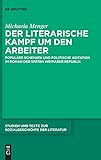Der literarische Kampf um den Arbeiter : Populäre Schemata und politische Agitation im Roman der späten Weimarer Republik / Michaela Menger.
Material type: TextSeries: Studien und Texte zur Sozialgeschichte der Literatur ; 145Publisher: Berlin ; Boston : De Gruyter, [2016]Copyright date: ©2017Description: 1 online resource (VIII, 517 p.)Content type:
TextSeries: Studien und Texte zur Sozialgeschichte der Literatur ; 145Publisher: Berlin ; Boston : De Gruyter, [2016]Copyright date: ©2017Description: 1 online resource (VIII, 517 p.)Content type: - 9783110465839
- 9783110467796
- 9783110468434
- Communism and literature -- History -- 20th century -- Germany
- Communism and literature -- Germany -- History -- 20th century
- German literature -- History and criticism -- 20th century
- German literature -- 20th century -- History and criticism
- Literature in propaganda -- History -- 20th century -- Germany
- Literature in propaganda -- Germany -- History -- 20th century
- Politics and literature -- History -- 20th century -- Germany
- Politics and literature -- Germany -- History -- 20th century
- Working class in literature
- Kommunismus
- Literaturpolitik
- Nationalsozialismus
- Weimarer Republik
- LITERARY CRITICISM / European / German
- Communism
- National Socialism
- Weimar Republic
- propaganda
- 830.9/358 23/eng/20230216
- online - DeGruyter
- Issued also in print.
| Item type | Current library | Call number | URL | Status | Notes | Barcode | |
|---|---|---|---|---|---|---|---|
 eBook
eBook
|
Biblioteca "Angelicum" Pont. Univ. S.Tommaso d'Aquino Nuvola online | online - DeGruyter (Browse shelf(Opens below)) | Online access | Not for loan (Accesso limitato) | Accesso per gli utenti autorizzati / Access for authorized users | (dgr)9783110468434 |
Dissertation Universität Mainz 2015.
Frontmatter -- Inhaltsverzeichnis -- Dank -- Einleitung -- 1. Populäre Schemata und politische Agitation -- 2. Literaturpolitische Hintergründe der Romane -- 3. Rezeptionsbedingungen der Romane und Lektüreverhalten der Arbeiter -- 4. Signalbereiche der paratextuellen Kommunikation -- 5. Analyse ausgewählter Romane -- Schluss -- Literaturverzeichnis -- Abbildungsverzeichnis -- Anhang -- Personenregister
restricted access online access with authorization star
http://purl.org/coar/access_right/c_16ec
In der späten Weimarer Republik konkurrieren die NSDAP und KPD primär um eine breite Zielgruppe: den Arbeiter. Dabei werden die zeitgenössischen politischen Konflikte und Kämpfe um Deutungshoheit keineswegs nur auf der Straße oder in Parteiversammlungen ausgetragen – auch Literatur gilt als wirkmächtige ,Waffe‘. Die Studie fragt nach den Voraussetzungen und Strategien der Nutzbarmachung populärer Schemata zur Agitation von Arbeitern. Literaturpolitische, buchgestalterische, mentalitätsgeschichtliche und rezeptionelle Aspekte stehen genauso im Fokus wie die eingehende narratologische Analyse literarischer Beispiele. Somit richtet sich die Untersuchung nicht nur an Literatur- und Kulturwissenschaftler im engeren Sinne, sondern ist auch für Historiker und Sozialwissenschaftler von Relevanz, da sie neue Perspektiven auf die zeitgenössischen Deutungsangebote, insbesondere auf die Konstruktion von Selbst- und Feindbildern, soziale Abgrenzungsmechanismen sowie auf die sozio-kulturellen Verfahren politischer Agitation eröffnet.
In the years 1930–1933, the NSDAP competed with the Communist Party to win over a broad target audience: the workers. Literature was one of their weapons in this battle. The study examines the underlying premises and methods behind the popular schemata used for agitating the working class. It focuses on aspects of literary politics, book design, the history of mentalities, and reception along with a narratological analysis of literary examples.
Issued also in print.
Mode of access: Internet via World Wide Web.
In German.
Description based on online resource; title from PDF title page (publisher's Web site, viewed 25. Jun 2024)


